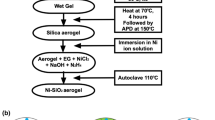Abstract
A major research theme to emerge in the science and technology of materials is the incorporation of nanostructure into the functionality of properties. Such nanostructured materials can offer distinct advantages over bulk materials, partly because the physical properties of the material itself can vary in a tunable, size-dependent fashion. Of course, in addition, nanoparticles offer a greatly increased surface area for chemical reaction. Typical methods for nanoparticle synthesis include: reaction in the liquid phase using the sol–gel approach and mechanical ball-milling of the bulk material; both of these approaches are somewhat problematic for the preparation of reactive nanostructured materials which are sensitive to air and/or moisture. We report here the formation of crystalline nanoparticles of sodium hydride encapsulated in a host amorphous silica gel matrix. These nanoparticles are formed by in situ hydrogenation of a precursor material—Na loaded silica gel—under mild conditions. The resulting material is considerably less pyrophoric and less air-sensitive than the bulk hydride. We anticipate that this formation method of in situ modification of reactive precursor material may have wide applications.




Similar content being viewed by others
References
W. Grochala and P. P. Edwards (2004). Chem. Rev. 104, (3), 1283–1315.
A. Zuttel (2004). Naturwissenschaften 91, (4), 157–172.
W. M. Mueller, J. P. Blackledge, and G. G. Libowitz Metal Hydrides (Academic Press, New York, 1968).
B. Schmidt and M. Pohler (2003). Org. Biomol. Chem. 1, (14), 2512–2517.
Y. H. Fan, et al. (2006). J. Nanopart. Res. 8, (6), 935–942.
Z. Wang, W. Zhou, and G. Lin (1985). Tetrahedron Lett. 26, (50), 6221–6224.
L. Paquette (ed.) Encyclopedia of Reagents for Organic Synthesis (Wiley, New York, 2004).
P. Caubere (1983). Angew. Chem. Int. Ed. Engl. 22, (8), 599–613.
M. A. Hayward and M. J. Rosseinsky (2003). Solid State Sci. 5, (6), 839–850.
P. A. A. Klusener, et al. (1986). Angew. Chem. Int. Ed. Engl. 25, (5), 465–466.
R. Pi, et al. (1987). J. Org. Chem. 52, (19), 4299–4303.
J. L. Dye, et al. (2005). J. Am. Chem. Soc. 127, (26), 9338–9339.
M. Shatnawi, et al. (2007). J. Am. Chem. Soc. 129, (5), 1386–1392.
P. C. H. Mitchell, et al., in J. L. Finney and D. L. Worcester (eds.), Vibrational Spectroscopy with Neutrons with Applications in Chemistry, Biology, Materials Science and Catalysis. Series on neutron techniques and applications (World Scientific, Singapore, 2005), p. 642.
G. Auffermann, et al. (2004). J. Phys. Condens. Matter 16, (32), 5731–5743.
J. A. Weil, J. R. Bolton, and J. E. Wertz Electron Paramagnetic Resonance: Elementary Theory, Practical Applications (Wiley, New York, 1994).
R. N. Edmonds, et al. (1984). J. Phys. Chem. 88, (17), 3764–3771.
L. Li, et al. (2009). Angew. Chem. Int. Ed. 48, (36), 6678–6682.
H. M. Rietveld (1969). J. Appl. Crystallogr. 2, 65–71.
Acknowledgments
We would like to thank Dr Jeff Harmer of the Centre for Advanced Electron Resonance Spectroscopy (CÆSR) at the University of Oxford for his help and assistance with the ESR measurements, and STFC and ISIS for beam time on TOSCA instrument. We would like to thank SigNa Chem for providing the starting samples (Na-SG) and Professor J.L. Dye for many helpful discussions. AS thanks the Glasstone Research Fellowship; MS, MJTL and PPE thank the EPSRC and SAW thanks the Leverhulme Trust for funding.
Author information
Authors and Affiliations
Corresponding author
Electronic supplementary material
Below is the link to the electronic supplementary material.
Rights and permissions
About this article
Cite this article
Sartbaeva, A., Wells, S.A., Sommariva, M. et al. Formation of Crystalline Sodium Hydride Nanoparticles Encapsulated Within an Amorphous Framework. J Clust Sci 21, 543–549 (2010). https://doi.org/10.1007/s10876-010-0336-4
Received:
Published:
Issue Date:
DOI: https://doi.org/10.1007/s10876-010-0336-4




